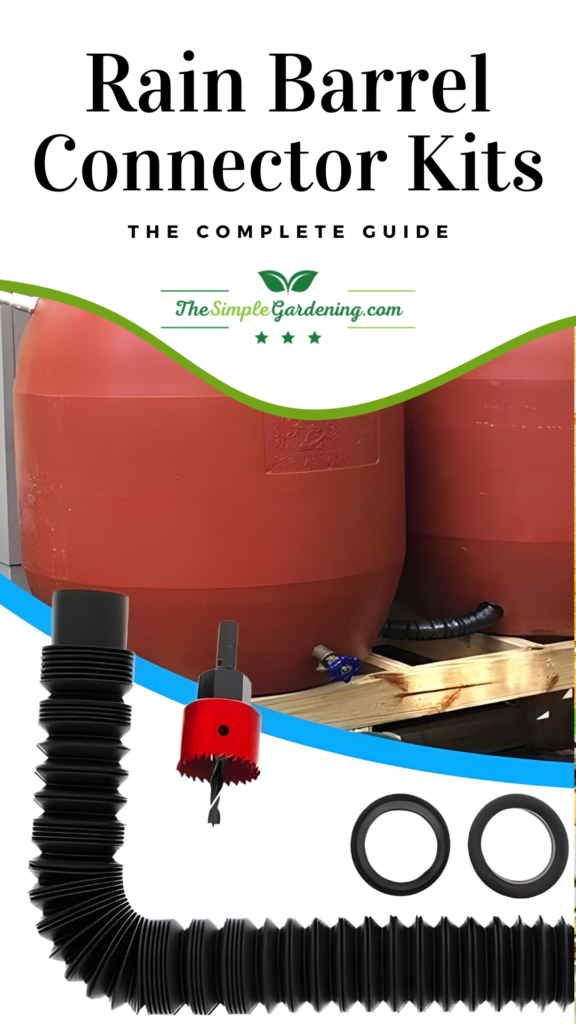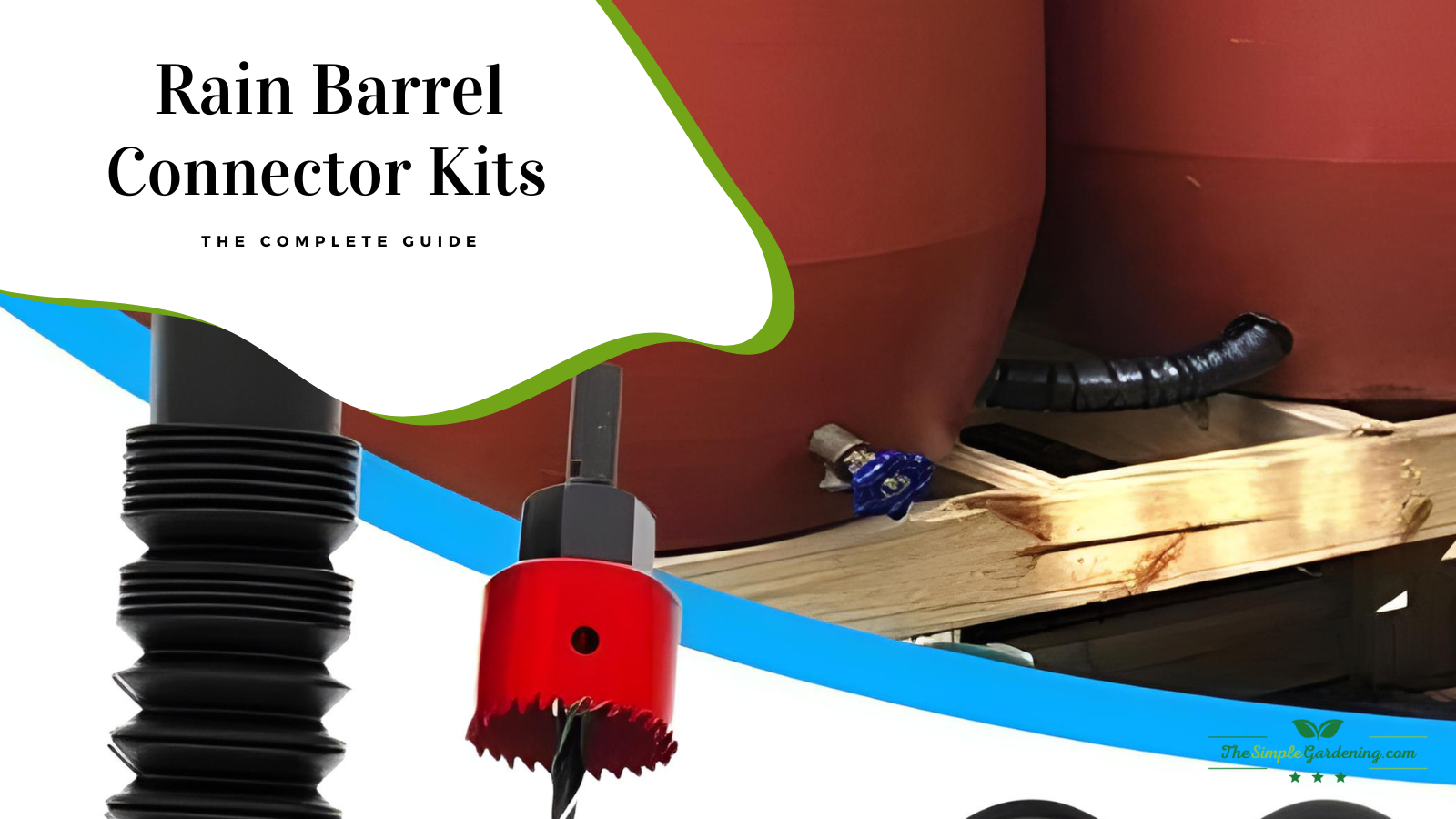Welcome to the comprehensive guide on rain barrel connector kits, your ultimate solution to conserving water and promoting sustainability in your gardening endeavors. In this article, we’ll delve into the various components, benefits, types, installation process, maintenance tips, and much more surrounding rain barrel connector kits. Whether you’re a seasoned gardener or just starting out, understanding these essential tools will revolutionize your approach to water conservation and landscape management.

Components of a Rain Barrel Connector Kit
Rain barrel connector kits typically comprise several essential components designed to facilitate seamless integration with your existing rain barrel system. These components often include downspout diverters, overflow connectors, seals, hoses, connectors, and various attachment accessories. Each component plays a crucial role in optimizing water collection and distribution, ensuring efficiency and effectiveness.
Benefits of Using Rain Barrel Connector Kits
The utilization of rain barrel connector kits offers a myriad of benefits for both the environment and the gardener. Firstly, it allows for the harvesting of rainwater, reducing reliance on municipal water sources and lowering water bills. Additionally, it promotes sustainable gardening practices by conserving water and minimizing runoff, thereby protecting natural waterways from pollution. Moreover, rain barrel connector kits provide a renewable source of water for irrigation, fostering healthier plant growth and reducing the ecological footprint of gardening activities.
Types of Rain Barrel Connector Kits
Downspout Diverter vs. Overflow Connector: When considering rain barrel connector kits, two primary types emerge: downspout diverters and overflow connectors. Downspout diverters are designed to redirect rainwater from the downspout into the rain barrel, ensuring efficient collection during rainfall events. On the other hand, overflow connectors facilitate the controlled release of excess water from the rain barrel, preventing overflow and potential water damage. Both types play integral roles in optimizing the functionality of rain barrel systems, providing versatility and adaptability to varying environmental conditions.
Compatibility with Different Rain Barrel Models and Sizes
One of the key considerations when selecting a rain barrel connector kit is its compatibility with different rain barrel models and sizes. Manufacturers often design connector kits to accommodate a range of barrel dimensions and configurations, ensuring universal applicability and ease of installation. Whether you have a small-scale residential rain barrel or a larger commercial-grade system, there exists a connector kit suitable for your specific requirements.
Installation Process for Rain Barrel Connector Kits
Installing a rain barrel connector kit is a straightforward process that can be accomplished with basic tools and minimal expertise. Begin by selecting an appropriate location for your rain barrel, ensuring sufficient clearance and stability. Next, assemble the components of the connector kit according to the manufacturer’s instructions, paying close attention to proper alignment and sealing. Then, attach the diverter or overflow connector to the downspout, ensuring a secure fit and reliable functionality. Finally, test the system to verify proper water flow and address any potential leaks or issues.
Tools Needed for Installing a Rain Barrel Connector Kit
To facilitate the installation of a rain barrel connector kit, several tools may be required depending on the specific kit and configuration. Commonly used tools include a hacksaw or pipe cutter for trimming hoses or pipes, adjustable wrenches for tightening fittings, a level for ensuring proper alignment, and a drill or screwdriver for securing mounting brackets or attachments. Additionally, caulking or waterproof sealant may be necessary to achieve a watertight seal at connection points.
Ensuring Proper Placement of Connectors for Efficient Water Collection
Achieving optimal water collection efficiency with rain barrel connector kits necessitates careful consideration of connector placement and orientation. Position the downspout diverter or overflow connector to maximize rainwater capture while minimizing obstructions or interference. Additionally, ensure that the connectors are situated at appropriate heights to facilitate seamless integration with the rain barrel and associated plumbing. Proper placement is essential for maximizing the effectiveness of the system and minimizing water loss.
Sealing and Securing Connections to Prevent Leaks
Preventing leaks is paramount when installing a rain barrel connector kit to maintain efficient water collection and distribution. Prioritize thorough sealing and securement of all connections using appropriate techniques and materials. Apply silicone sealant or plumber’s tape to threaded fittings to create a watertight seal and prevent leakage. Additionally, use hose clamps or compression fittings to secure hoses and pipes, minimizing the risk of detachment or disconnection. Regularly inspect connections for signs of wear or deterioration and address any issues promptly to prevent water loss or damage.
Adjusting Downspout Diverters for Optimal Water Flow
Fine-tuning the operation of downspout diverters is essential for achieving optimal water flow and maximizing rainwater collection. Adjust the diverter mechanism to regulate the rate of water diversion based on rainfall intensity and volume. During heavy rain events, increase the diversion rate to prevent overflow and ensure efficient utilization of available rainwater. Conversely, during lighter showers or periods of low precipitation, adjust the diverter to minimize water loss and conserve resources effectively. Regular monitoring and adjustment of diverter settings will help optimize the performance of the rain barrel system throughout the year.
Adding Filters and Screens to Rain Barrel Connector Kits
Incorporating filters and screens into rain barrel connector kits serves to enhance water quality by removing debris, sediment, and contaminants from collected rainwater. Install mesh screens or filter inserts at key entry points, such as the downspout or inlet valve, to prevent leaves, twigs, and other debris from entering the system. Additionally, consider integrating finer filtration media or activated carbon filters to remove pollutants and improve water clarity further. Regular maintenance and cleaning of filters and screens are essential to ensure continued effectiveness and prevent clogging or obstruction.
Maintenance Tips for Rain Barrel Connector Kits
Proper maintenance is essential for ensuring the long-term functionality and durability of rain barrel connector kits. Perform regular inspections of the entire system, including connectors, hoses, seals, and fittings, to identify any signs of wear, damage, or leakage. Clean filters, screens, and inlet valves periodically to prevent clogging and maintain water quality. Additionally, flush the system with clean water to remove sediment and debris that may accumulate over time. In colder climates, winterize the rain barrel system to prevent freezing and damage to components. By adhering to a routine maintenance schedule, you can prolong the lifespan of your rain barrel connector kit and maximize its efficiency.
Winterizing Rain Barrel Connector Kits in Cold Climates
In regions with cold climates and freezing temperatures, winterizing rain barrel connector kits is essential to prevent damage and ensure continued functionality during the colder months. Begin by draining the rain barrel completely to remove any remaining water and prevent freezing. Disconnect hoses and fittings, and store them indoors to protect against frost damage. Install insulation sleeves or covers over exposed pipes and connectors to provide additional protection against freezing temperatures. Additionally, consider adding a heating element or heat tape to vulnerable components to maintain above-freezing temperatures. Regularly monitor weather forecasts and take proactive measures to safeguard your rain barrel system against winter-related hazards.
Troubleshooting Common Issues with Rain Barrel Connectors
Despite their simplicity, rain barrel connector kits may encounter occasional issues that require troubleshooting and resolution. Common problems include leaks, clogs, insufficient water flow, and improper operation of diverter mechanisms. When faced with such issues, begin by inspecting all connections and seals for signs of damage or deterioration. Tighten loose fittings, replace worn seals, and clear any obstructions or debris that may be affecting water flow. If necessary, adjust diverter settings or reinstall components to ensure proper functionality. Consulting the manufacturer’s instructions or seeking assistance from experienced professionals can help address more complex issues effectively.
Customizing Rain Barrel Connector Kits for Specific Needs
Flexibility and customization options are essential features of modern rain barrel connector kits, allowing users to tailor the system to meet their specific needs and preferences. Consider incorporating additional accessories such as rainwater filters, diverters, or expansion kits to enhance functionality and performance. Customize the layout and configuration of connectors to optimize water collection and distribution based on your unique landscape and gardening requirements. Furthermore, explore DIY modifications and upgrades to personalize your rain barrel system further and maximize its potential benefits. By embracing customization options, you can create a bespoke rainwater harvesting solution that aligns perfectly with your sustainability goals and gardening aspirations.
Expanding Rain Barrel Systems with Multiple Connectors
For larger-scale water harvesting projects or commercial applications, expanding rain barrel systems with multiple connectors offers a scalable solution to meet growing water demands. Connect multiple rain barrels in series or parallel configurations to increase storage capacity and improve water distribution efficiency. Utilize manifold systems and distribution networks to seamlessly integrate multiple barrels into a cohesive water management system. By strategically positioning connectors and valves, you can optimize the flow of water between barrels and ensure balanced utilization of stored rainwater. Regular monitoring and maintenance of expanded rain barrel systems are essential to prevent overflows, leaks, and other potential issues.
Rain barrel connector kits represent a practical and sustainable solution for harvesting rainwater and promoting environmental conservation in gardening and landscaping activities. By understanding the components, benefits, types, installation process, and maintenance considerations associated with these kits, you can harness the full potential of rainwater as a valuable resource. Whether you’re a novice gardener or an experienced enthusiast, integrating a rain barrel connector kit into your gardening arsenal will undoubtedly contribute to a greener, more sustainable future for generations to come. Embrace the power of rainwater harvesting and make a positive impact on the planet, one drop at a time.

